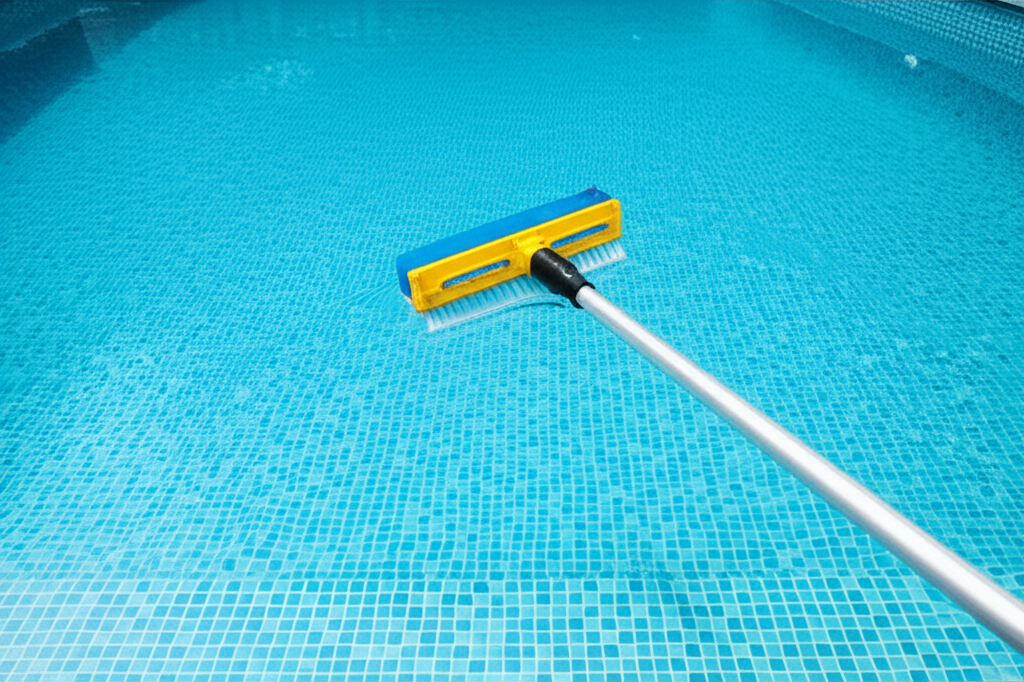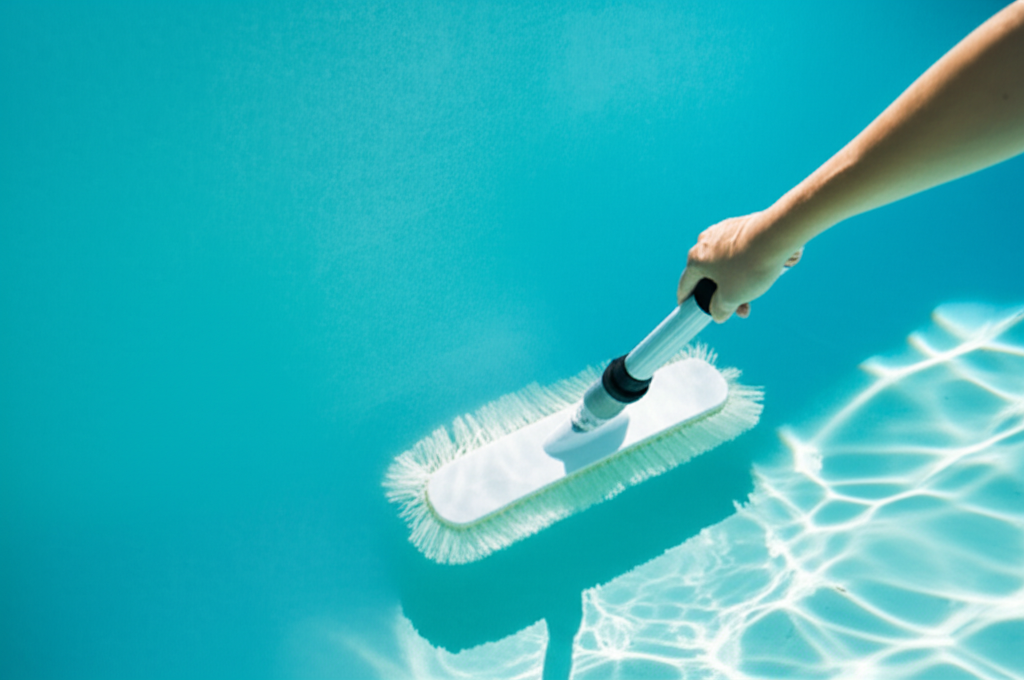- Why Brushing Pool Walls is So Important
- Choosing the Right Tools for Effective Brushing Pool Walls
- The Step-by-Step Guide to Brushing Pool Walls
- Tackling Stubborn Algae: Beyond Basic Brushing
- Common Mistakes to Avoid
Brushing Pool Walls is a fundamental, yet often underestimated, task in maintaining a pristine swimming pool. While it might seem like a chore, consistent and correct brushing plays a crucial role not just in aesthetics, but in the overall health and longevity of your pool. This guide will walk you through why it’s essential, how to do it effectively, and what tools you’ll need to keep your pool water sparkling clear and inviting.
Why Brushing Pool Walls is So Important
Many pool owners focus primarily on chemical balancing and filtration, but brushing pool walls is the proactive step that prevents many common pool problems before they escalate.
Algae Prevention: This is arguably the most significant benefit. Microscopic algae spores are always present in the air and water. They land on pool surfaces and, if undisturbed, can quickly take root, leading to unsightly and unhealthy algae blooms. Regular brushing dislodges these nascent organisms, sending them into the water where they can be filtered out or killed by sanitizers. This is where algae brushing becomes a preventative and curative powerhouse.
Improved Water Chemistry & Clarity: When you brush the walls and floor, you stir up stagnant water and circulate chemicals more effectively throughout the entire pool. This ensures sanitizers reach all areas, leading to more balanced chemistry and crystal-clear water. Debris and particles that cling to surfaces are also knocked loose, making it easier for your filter to capture them.
Extends Surface Lifespan: For pools with plaster or aggregate finishes, brushing helps prevent the buildup of mineral deposits and scaling, which can etch or stain the surface over time. For vinyl liner pools, it removes tiny abrasive particles that could potentially cause wear.
Dislodges Dirt and Debris: Even with the best filtration, fine dirt, pollen, and other organic matter can settle and cling to pool surfaces, especially in corners and steps. Brushing lifts these particles into suspension, allowing them to be vacuumed or filtered out.
Choosing the Right Tools for Effective Brushing Pool Walls
Having the correct equipment is half the battle when it comes to efficient pool maintenance.
The Brush Itself:
Nylon Brushes: These are the most versatile and safest for all pool surfaces, including vinyl liners, fiberglass, acrylic, and painted concrete. Their soft bristles are effective at removing light buildup without scratching.
Polypropylene Brushes: Similar to nylon, these are also safe for all surfaces and are a good general-purpose option.
Stainless Steel Brushes: These are specifically designed for plaster, gunite, or concrete pools. Their firm bristles are excellent for scrubbing away stubborn algae (especially black algae) and mineral deposits. Never use a stainless steel brush on vinyl, fiberglass, or painted surfaces, as it will cause irreversible damage.
Combination Brushes: Some brushes feature a mix of nylon and stainless steel bristles, providing a good all-around option for plaster pools that need a bit more scrubbing power.
Telescopic Pole: Essential for reaching all areas of your pool, a sturdy, adjustable telescopic pole made of aluminum or fiberglass will allow you to extend your reach across the pool floor and up the walls.
Other Essentials: While not directly for brushing, ensuring your filter is clean and your vacuum is ready for post-brushing cleanup is crucial. Safety goggles and gloves can also be beneficial, especially when dealing with chemicals or particularly stubborn growth.
The Step-by-Step Guide to Brushing Pool Walls
Consistency is key. Aim to brush your pool at least once a week, and more frequently if you notice algae growth or after a heavy storm.
1. Preparation: Before you begin, ensure your pool’s filtration system is running. This will help circulate the water and capture dislodged particles. If you suspect an algae problem, it’s often best to brush before adding extra chemicals like shock, as brushing helps break up the algae and open its protective layers, making chemical treatments more effective.
2. Start at the Top: Begin brushing from the waterline down. Work your way around the entire perimeter of the pool, applying firm but controlled pressure. Overlap your strokes slightly to ensure you don’t miss any spots.
3. Work Down to the Floor: Once you’ve brushed all the walls, move to the steps, benches, and any other submerged features. Finally, brush the pool floor, pushing any dislodged debris towards the main drain or into the center of the pool where it can be vacuumed.
4. Pay Attention to Problem Areas: Corners, crevices, behind ladders, and shadowed spots are prime locations for algae growth. Give these areas extra attention. If you spot specific patches of algae, focus your algae brushing efforts there.
5. Post-Brushing Cleanup: After you’ve brushed the entire pool, let the filter run for several hours (or even overnight) to capture the loosened debris. If there’s a significant amount of fine particles or algae still visible, a manual vacuum to waste (if your filter allows) is often the most efficient way to remove it without overloading your filter. If you’ve been tackling an algae bloom, consider shocking the pool after brushing, then vacuuming the following day.
Tackling Stubborn Algae: Beyond Basic Brushing
When green, black, or mustard algae takes hold, regular maintenance brushing might not be enough. This is where aggressive algae brushing becomes critical.
Green Algae: The most common type. Thorough brushing of all surfaces, followed by a strong shock treatment, is usually effective. Ensure you brush vigorously to break up the algae’s protective layer.
Mustard Algae (Yellow Algae): This can be more resistant. It often resembles dirt or pollen. It requires very aggressive scrubbing, multiple shock treatments, and often a specialized algaecide specifically formulated for mustard algae. Be meticulous with your algae brushing here.
Black Algae: The toughest foe. Black algae forms deep roots into plaster surfaces, making it incredibly difficult to remove. Use a dedicated stain/algae brush (stainless steel for plaster pools) and scrub aggressively to break through its protective cap. Repeat over several days, combined with concentrated treatments of chlorine tablets placed directly on the spots (for plaster pools only, not vinyl) or specialized black spot removers. You will likely see the best results from a combination of chemicals and robust physical algae brushing.
Common Mistakes to Avoid
Using the Wrong Brush: As mentioned, a stainless steel brush on a vinyl liner will ruin your pool. Always match your brush type to your pool surface.
Infrequent Brushing: Waiting until you see algae is already too late. Regular, proactive brushing prevents the problem from starting.
Skipping Areas: Don’t neglect the “hidden” spots like behind ladders, inside skimmer throats, or under steps. These are often breeding grounds for algae.
Not Following Up with Filtration/Vacuuming: Brushing loosens debris; your filter or vacuum removes it. Without this crucial second step, you’re merely moving the problem around.
* Brushing Only When Algae Appears: While essential for existing algae, regular brushing prevents its return.
Brushing pool walls is not just about keeping up appearances; it’s a vital component of a comprehensive pool maintenance regimen that promotes sanitation, water clarity, and the longevity of your pool’s surfaces. By committing to regular brushing with the right tools and techniques, you’ll ensure your backyard oasis remains a sparkling, healthy, and inviting place to relax and enjoy.




